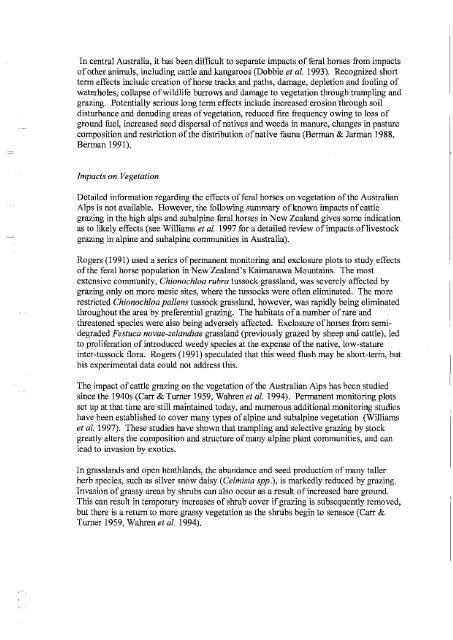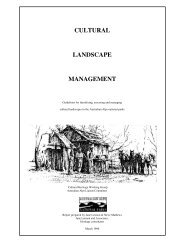Assessment of Impacts of Feral Horses - Australian Alps National ...
Assessment of Impacts of Feral Horses - Australian Alps National ...
Assessment of Impacts of Feral Horses - Australian Alps National ...
Create successful ePaper yourself
Turn your PDF publications into a flip-book with our unique Google optimized e-Paper software.
In central Australia, it has been difficult to separate impacts <strong>of</strong> feral horses from impacts<br />
<strong>of</strong> other animals, including cattle and kangaroos (Dobbie et al. 1993). Recognized short<br />
term effects include creation <strong>of</strong> horse tracks and paths, damage, depletion and fouling <strong>of</strong><br />
waterholes, collapse <strong>of</strong> wildlife burrows and damage to vegetation through trampling and<br />
grazing. Potentially serious long term effects include increased erosion through soil<br />
disturbance and denuding areas <strong>of</strong> vegetation, reduced fire frequency owing to loss <strong>of</strong><br />
ground fuel, increased seed dispersal <strong>of</strong> natives and weeds in manure, changes in pasture<br />
composition and restriction <strong>of</strong> the distribution <strong>of</strong> native fauna (Berman & Jarman 1988,<br />
Berman 1991).<br />
<strong>Impacts</strong> on Vegetation<br />
I !<br />
~<br />
,I (<br />
, ,<br />
Detailed information regarding the effects <strong>of</strong> feral horses on vegetation <strong>of</strong> the <strong>Australian</strong><br />
<strong>Alps</strong> is not available. However, the following summary <strong>of</strong> known impacts <strong>of</strong> cattle.<br />
grazing in the high alps and sUbalpine feral horses in New Zealand gives some indication<br />
as to likely effects (see Williams et al. 1997 for a detailed review <strong>of</strong> impacts <strong>of</strong>livestock<br />
grazing in alpine and subalpine communities in Australia).<br />
Rogers (1991) used a series <strong>of</strong> permanent monitoring and exclosure plots to study effects<br />
<strong>of</strong> the feral horse population in New Zealand's Kaimanawa Mountains. The most<br />
extensive community, Chionochloa rubra tussock grassland, was severely affected by<br />
grazing only on more mesic sites, where the tussocks were <strong>of</strong>ten eliminated. The more<br />
restricted Chionochloa pallens tussock grassland, however, was rapidly being eliminated<br />
throughout the area by preferential grazing. The habitats <strong>of</strong> a number <strong>of</strong> rare and<br />
threatened species were also being adversely affected. Exclosure <strong>of</strong> horses from semidegraded<br />
Festuca novae-zelandiae grassland (previously grazed by sheep and cattle), led<br />
to proliferation <strong>of</strong> introduced weedy species at the expense <strong>of</strong> the native, low-stature<br />
inter-tussock flora. Rogers (1991) speculated that this weed flush may be short-term, but<br />
his experimental data could not address this.<br />
The impact <strong>of</strong> cattle grazing on the vegetation <strong>of</strong> the <strong>Australian</strong> <strong>Alps</strong> has been studied<br />
since the 1940s (Carr & Turner 1959, Wahren et al. 1994). Permanent monitoring plots<br />
set up at that time are still maintained today, and numerous additional monitoring studies<br />
have been established to cover many types <strong>of</strong> alpine and subalpine vegetation (Williams<br />
et al. 1997). These studies have shown that trampling and selective grazing by stock<br />
greatly alters the composition and structure <strong>of</strong> many alpine plant communities, and can<br />
lead to invasion by exotics.<br />
In grasslands and open heathlands, the abundance and seed production <strong>of</strong> many taller<br />
herb species, such as silver snow daisy (Celmisia spp.), is markedly reduced by grazing.<br />
Invasion <strong>of</strong> grassy areas by shrubs can also occur as a result <strong>of</strong> increased bare ground.<br />
This can result in temporary increases <strong>of</strong> shrub cover if grazing is subsequently removed,<br />
but there is a return to more grassy vegetation as the shrubs begin to senesce (Carr &<br />
Turner 1959, Wahren et al. 1994).
















